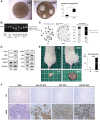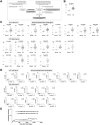Constitutive Activation of the Tumor Suppressor p53 in Hepatocytes Paradoxically Promotes Non-Cell Autonomous Liver Carcinogenesis
- PMID: 35696550
- PMCID: PMC9379366
- DOI: 10.1158/0008-5472.CAN-21-4390
Constitutive Activation of the Tumor Suppressor p53 in Hepatocytes Paradoxically Promotes Non-Cell Autonomous Liver Carcinogenesis
Abstract
In chronic liver diseases (CLD), p53 is constitutively activated in hepatocytes due to various etiologies as viral infection, ethanol exposure, or lipid accumulation. This study was aimed to clarify the significance of p53 activation on the pathophysiology of CLDs. In Kras-mutant liver cancer model, murine double minute 2 (Mdm2), a negative regulator of p53, was specifically deleted in hepatocytes [Alb-Cre KrasLSL-G12D Mdm2fl/fl (LiKM; KrasG12D mutation and Mdm2 loss in the liver)]. Accumulation of p53 and upregulation of its downstream genes were observed in hepatocytes in LiKM mice. LiKM mice showed liver inflammation accompanied by hepatocyte apoptosis, senescence-associated secretory phenotype (SASP), and the emergence of hepatic progenitor cells (HPC). More importantly, Mdm2 deletion promoted non-cell autonomous development of liver tumors. Organoids generated from HPCs harbored tumor-formation ability when subcutaneously inoculated into NOD/Shi-scid/IL2Rγ (null) mice. Treatment with acyclic retinoid suppressed growth of HPCs in vitro and inhibited tumorigenesis in LiKM mice. All of the phenotypes in LiKM mice, including accelerated liver tumorigenesis, were negated by further deletion of p53 in hepatocytes (Alb-Cre KrasLSL-G12D Mdm2fl/fl p53fl/fl). Activation of hepatic p53 was noted in liver biopsy samples obtained from 182 patients with CLD, in comparison with 23 normal liver samples without background liver diseases. In patients with CLD, activity of hepatic p53 was positively correlated with the expression of apoptosis, SASP, HPC-associated genes and tumor incidence in the liver after biopsy. In conclusion, activation of hepatocyte p53 creates a microenvironment prone to tumor formation from HPCs. Optimization of p53 activity in hepatocytes is important to prevent patients with CLD from hepatocarcinogenesis.
Significance: This study reveals that activation of p53 in hepatocytes promotes liver carcinogenesis derived from HPCs, which elucidates a paradoxical aspect of a tumor suppressor p53 and novel mechanism of liver carcinogenesis. See related commentary by Barton and Lozano, p. 2824.
©2022 The Authors; Published by the American Association for Cancer Research.
Figures

![Figure 1. Hepatocyte-specific Mdm2 deletion in LiK (KrasG12D mutation specifically in the liver) mice promoted the development of liver tumors. Hepatocyte-specific KrasG12D-mutant mice (KrasLSL-G12D/+ Alb-Cre; LiK (KrasG12D mutation in the liver) mice) and Mdm2-floxed mice were mated to generate hepatocyte-specific Mdm2-knockout KrasG12D mice. After the mating of Mdm2fl/+ Kras+/+Alb-Cre mice and Mdm2fl/+ KrasLSL-G12D/+ mice, the phenotypes of the following offspring groups were analyzed at 4 months of age (A, B, D) or subjected to survival analysis (C); (1) KrasG12D Mdm2+/+ (LiK) (Mdm2+/+ KrasLSL-G12D/+ Alb-Cre); (2) KrasG12D Mdm2+/del (Mdm2fl/+ KrasLSL-G12D/+ Alb-Cre; LiKM [KrasG12D mutation and Mdm2 loss in the liver)-hetero mice]; and (3) KrasG12D Mdm2del/del (Mdm2fl/fl KrasLSL-G12D/+ Alb-Cre; LiKM mice) littermates. A, Macroscopic appearance of the livers. B, Macroscopic tumor number, maximum tumor diameter, and liver to body weight ratio (N = 10–21 per group). C, Kaplan–Meier survival analysis (N = 12–14 per group). D, H&E staining in the liver (×100). Arrowheads indicate tumors. LiKM mice were mated with ROSA26-LacZ mice, and the KrasG12D Mdm2del/del ROSA26-LacZ offspring mice were sacrificed at 4 months of age (E–F). E, β-Galactosidase staining of the liver (×100, left; and ×200, right). F, Genotyping of the Mdm2 gene in tumorous (T) and nontumorous (NT) tissues in KrasG12D Mdm2del/del ROSA26-LacZ mice. Tissue DNA was extracted from both tumorous and nontumorous liver tissues collected via laser microdissection after β-galactosidase staining. The DNA band was separated by electrophoresis after PCR. *, P < 0.05.](https://cdn.ncbi.nlm.nih.gov/pmc/blobs/a4c8/9379366/78435ebd44e5/2860fig1.gif)






Comment in
-
p53 Activation Paradoxically Causes Liver Cancer.Cancer Res. 2022 Aug 16;82(16):2824-2825. doi: 10.1158/0008-5472.CAN-22-2065. Cancer Res. 2022. PMID: 35971677
Similar articles
-
p53 Activation Paradoxically Causes Liver Cancer.Cancer Res. 2022 Aug 16;82(16):2824-2825. doi: 10.1158/0008-5472.CAN-22-2065. Cancer Res. 2022. PMID: 35971677
-
Lipopolysaccharide induces the differentiation of hepatic progenitor cells into myofibroblasts constitutes the hepatocarcinogenesis-associated microenvironment.Cell Death Differ. 2020 Jan;27(1):85-101. doi: 10.1038/s41418-019-0340-7. Epub 2019 May 7. Cell Death Differ. 2020. PMID: 31065105 Free PMC article.
-
Early onset of pathological polyploidization and cellular senescence in hepatocytes lacking RAD51 creates a pro-fibrotic and pro-tumorigenic inflammatory microenvironment.Hepatology. 2025 Feb 1;81(2):491-508. doi: 10.1097/HEP.0000000000000821. Epub 2024 Mar 11. Hepatology. 2025. PMID: 38466833 Free PMC article.
-
Increases in p53 expression induce CTGF synthesis by mouse and human hepatocytes and result in liver fibrosis in mice.J Clin Invest. 2011 Aug;121(8):3343-56. doi: 10.1172/JCI44957. Epub 2011 Jul 11. J Clin Invest. 2011. PMID: 21747166 Free PMC article.
-
Immunomodulatory Function of the Tumor Suppressor p53 in Host Immune Response and the Tumor Microenvironment.Int J Mol Sci. 2016 Nov 19;17(11):1942. doi: 10.3390/ijms17111942. Int J Mol Sci. 2016. PMID: 27869779 Free PMC article. Review.
Cited by
-
Assessing phototoxic drug properties of hydrochlorothiazide using human skin biopsies.Commun Biol. 2025 May 6;8(1):705. doi: 10.1038/s42003-025-08064-1. Commun Biol. 2025. PMID: 40328921 Free PMC article.
-
p53 enhances elesclomol-Cu-induced cuproptosis in hepatocellular carcinoma via FDXR-mediated FDX1 upregulation.Front Oncol. 2025 Jun 24;15:1584811. doi: 10.3389/fonc.2025.1584811. eCollection 2025. Front Oncol. 2025. PMID: 40630211 Free PMC article.
-
p53/E2F7 axis promotes temozolomide chemoresistance in glioblastoma multiforme.BMC Cancer. 2024 Mar 7;24(1):317. doi: 10.1186/s12885-024-12017-y. BMC Cancer. 2024. PMID: 38454344 Free PMC article.
-
High-Frequency Mutations in TP53, AXIN1, CTNNB1, and KRAS, and Polymorphisms in JAK1 Genes Among Mongolian HCC Patients.Cancer Rep (Hoboken). 2025 May;8(5):e70227. doi: 10.1002/cnr2.70227. Cancer Rep (Hoboken). 2025. PMID: 40344393 Free PMC article.
-
Targeting inflammation in cancer therapy: from mechanistic insights to emerging therapeutic approaches.J Transl Med. 2025 May 26;23(1):588. doi: 10.1186/s12967-025-06583-3. J Transl Med. 2025. PMID: 40420174 Free PMC article. Review.
References
-
- Lane DP. Cancer. p53, guardian of the genome. Nature 1992;358:15–16. - PubMed
-
- Bode AM, Dong Z. Posttranslational modification of p53 in tumorigenesis. Nat Rev Cancer 2004;4:793–805. - PubMed
-
- Totoki Y, Tatsuno K, Covington KR, Ueda H, Creighton CJ, Kato M, et al. . Trans-ancestry mutational landscape of hepatocellular carcinoma genomes. Nat Genet 2014;46:1267–73. - PubMed
Publication types
MeSH terms
Substances
LinkOut - more resources
Full Text Sources
Medical
Molecular Biology Databases
Research Materials
Miscellaneous

